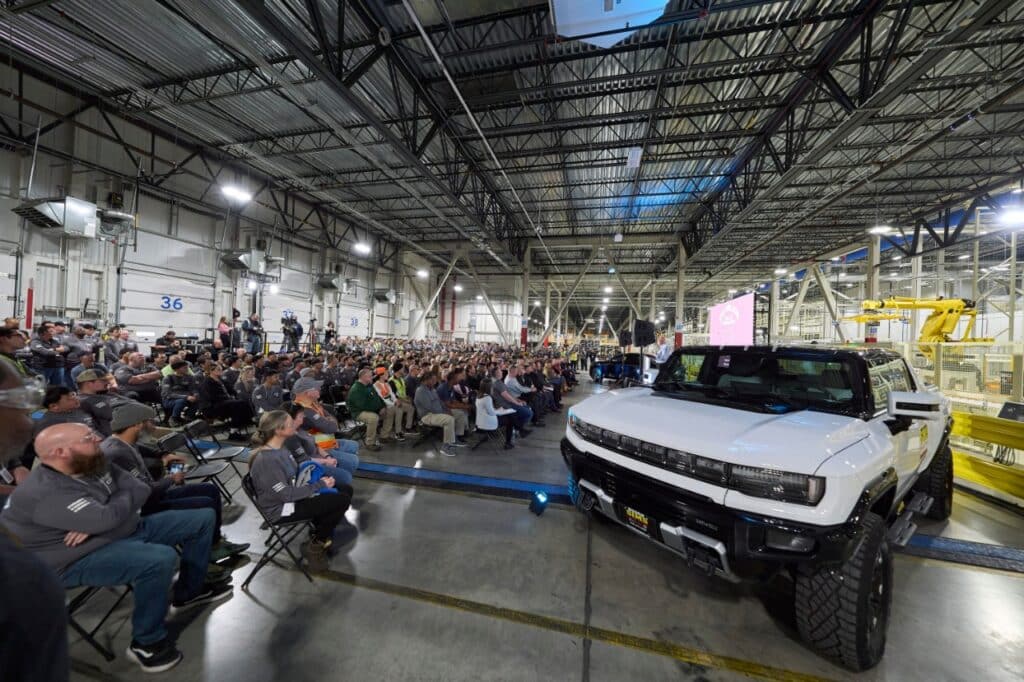GM’s Ultium Cells Produced 100M EV Battery Cells, Signs Multi-Billion Deal for Synthetic Graphite
In December, Ultium Cells celebrated a major milestone: the production of its 100 millionth EV battery cell at the Ultium Cells Warren plant. Every day, in Warren, Ohio, and Spring Hill, Tennessee, the dedicated team at Ultium Cells— a joint venture between LG Energy Solution and General Motors—plays a crucial role in advancing the transition to an all-electric future. At these manufacturing plants, Ultium Cells produces millions of battery cells with precision and quality, which are vital components of the battery systems that power General Motors’ diverse and expanding range of electric vehicles. The pouch battery cells produced at these facilities are used in everything from the all-electric Cadillac Lyriq luxury SUV to the high-performance GMC Hummer EV, offering customers increased choice and access to cutting-edge EV technology.
The celebration in Warren was a testament to the hard work and innovation behind Ultium Cells’ achievements. Walking through the facility, one can see firsthand how the collaboration between Ultium Cells and LG Energy Solution has helped establish an electrification powerhouse, laying the foundation for an electric future.

Ultium Cells’ joint venture brings together cutting-edge technology, advanced manufacturing processes, and a talented, dedicated workforce. As a result, Ultium Cells has emerged as one of the largest battery cell manufacturers in North America, showcasing how American innovation and manufacturing are driving the future of mobility.
The 14-year technology partnership between General Motors and LG Energy Solution has been pivotal in supporting GM’s strategy to deliver superior EV performance, greater choice, and increased value to customers. Innovative battery technologies, such as those produced at the Ultium Cells Warren plant, are integral to this strategy.
Building on the significant progress made in Warren and across the Ultium Cells joint venture, the partnership is advancing even further. GM and LG Energy Solution are now extending their collaboration to jointly develop prismatic cells, marking a new phase in their relationship. This expansion will help deliver even greater value, performance, and choice to EV customers through a broader range of battery cell chemistries and form factors.
As they celebrate the production of the 100 millionth battery cell at Ultium Cells Warren, the team is already focused on the future, continuing to push the boundaries of what is possible through this groundbreaking partnership.
GM Signs Multi-Billion Dollar Supply Deal With Vianode for Synthetic Graphite for EV Batteries
On January 15, 2025, General Motors (GM) announced a multi-year, multi-billion dollar agreement with Vianode, a Norwegian company, to supply synthetic graphite anode materials for its electric vehicle (EV) batteries. The synthetic graphite will be used in the EV batteries produced by Ultium Cells, a joint venture between GM and LG Energy Solution.
This deal, set to begin in 2027, will extend through 2033, aligning with Vianode’s plan to launch production at a new plant in North America. While the exact location remains undisclosed due to ongoing negotiations, the plant will be situated in the United States or Canada, strategically close to GM and LG’s battery production facilities.
In the first phase of production, Vianode aims to produce approximately 80,000 tons of synthetic graphite annually by 2030, enough to support around 1.5 million EVs. Vianode’s existing plant in Herøya, Norway, is already operational, and the company is in discussions to supply additional automakers.
Vianode’s synthetic graphite production offers a significant environmental advantage, with a 90% lower CO2 footprint compared to conventional graphite production methods. Additionally, the company’s ability to scale up its operations more rapidly than traditional mining makes it an important player in the global EV supply chain, particularly as the automotive industry seeks to reduce reliance on China, which currently controls 95% of the world’s graphite supply.
The 90% lower CO2 footprint is one example, out of many, that EV battery production is becoming more eco-friendly every quarter. Additionally, better, more efficient and more cost-effective EV battery technologies are being developed at light speed in America. EV battery production is quickly scaling up in the US, lessening supply chain problems from China’s domination of the EV battery industry.

Electric Vehicle Marketing Consultant, Writer and Editor. Publisher EVinfo.net.
Services